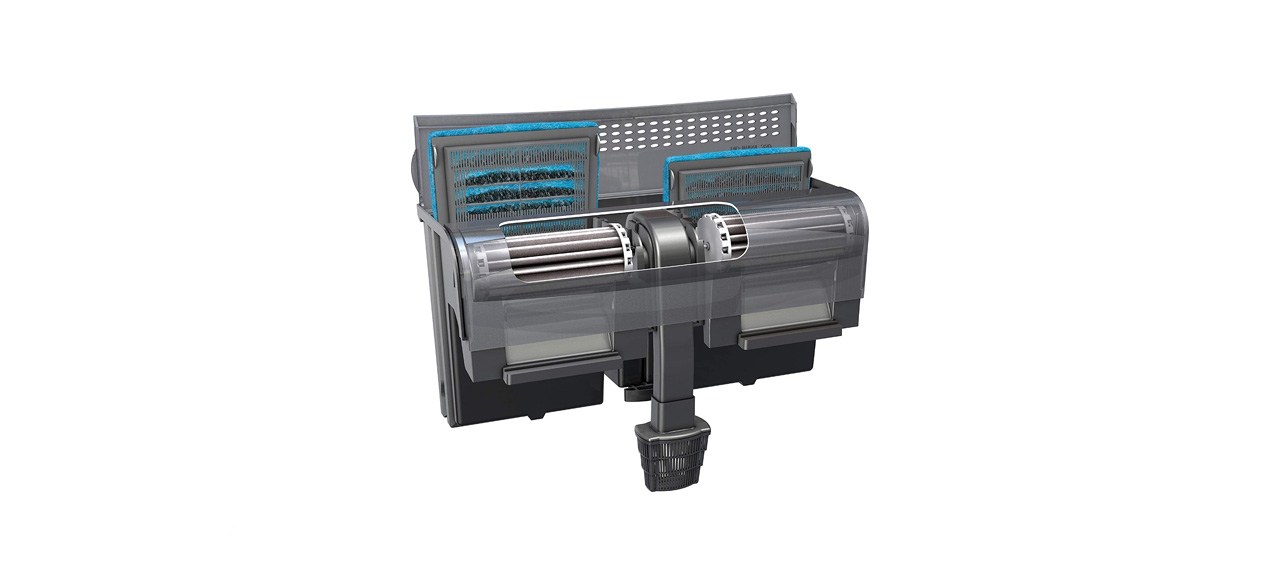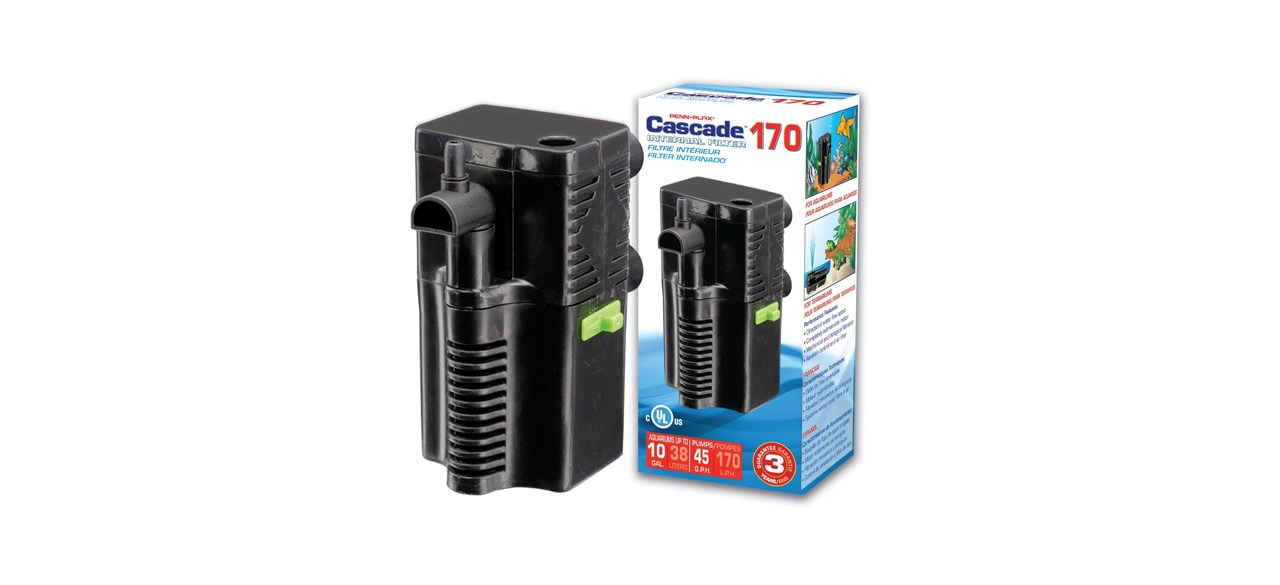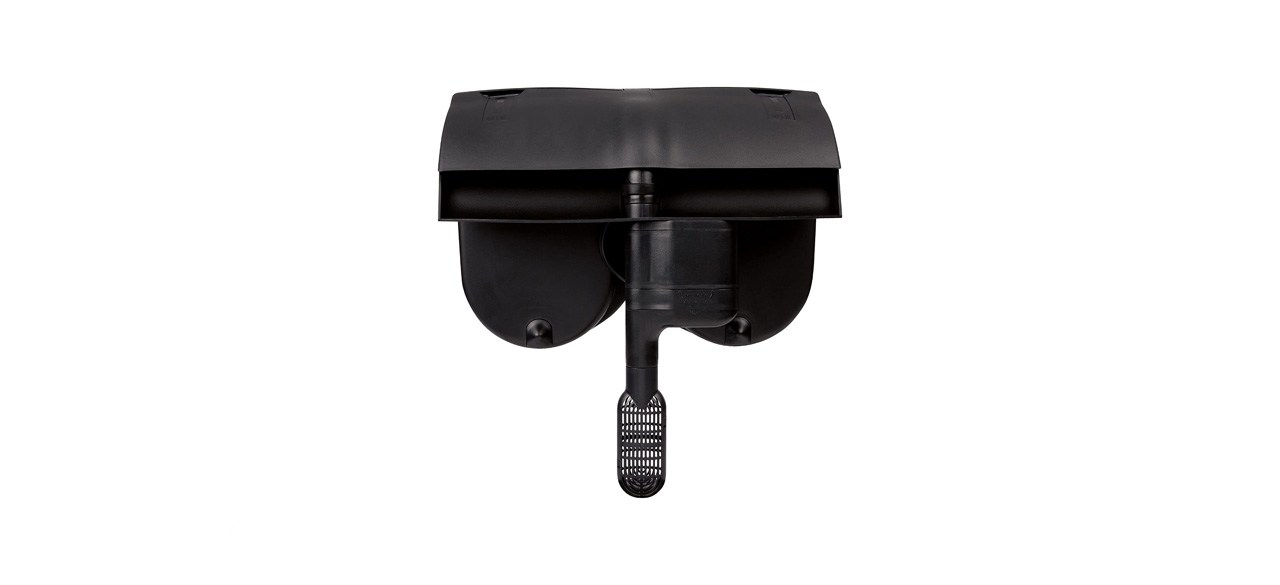Which aquarium filter is best?
Aquarium filters remove waste and debris from your fish tank while neutralizing harmful chemicals, such as ammonia and nitrates. Choosing the right filter for your tank will help keep your fish happy and healthy.
It’s important to know about the different filtration types, as they all play a part in keeping aquarium water clean. If you’re looking for an effective yet reasonably priced filter, the Marineland Penguin Bio-Wheel Power Filter is an excellent choice.
What to know before you buy an aquarium filter
Types of filtration
There are three types, or stages, of filtration. Ideally, a quality filter should provide all three.
- Mechanical filtration separates out solid debris from the water, including fish waste and left-over food.
- Chemical filtration traps harmful chemicals, toxins and tannins. Activated charcoal is the most common type of chemical filtration media.
- Biological filtration provides an environment that encourages colonies of good bacteria to grow. Once established, these colonies get rid of harmful bacteria and certain toxins, such as ammonia.
Types of aquarium filters
These are some of the most common types of aquarium filters.
- Power filters, also known as hang-on-back filters, sit over the back of the tank. These filters are affordable and reasonably powerful. They usually provide three-stage chemical, mechanical and biological filtration.
- Internal power filters are also known as submersible filters because you can submerge them completely in the water. They’re usually quiet and affordable, but they’re only suitable for relatively compact tanks.
- Canister filters are perfect for large tanks. They have big empty spaces inside to add your own choice of media rather than being restricted to cartridges. They’re great for experienced fish-keepers.
- Sponge filters attach to air pumps, driving tank water through them. They provide biological filtration, which is effective on its own for a small tank, but you may need secondary mechanical or chemical filters for larger tanks.
What to look for in a quality aquarium filter
Flow rate
The flow rate refers to how much water a filter can turn over per hour. Filters with higher flow rates are suitable for bigger tanks, but manufacturers will list the tank size, so you don’t have to do the math. Higher flow rates also provide more water movement. Some filters let you adjust the flow, so you don’t create excessive movement.
Cartridges
Many filters have replaceable cartridges for mechanical and chemical filtration. This makes them easy to replace; just take out the old cartridge and replace it with a new one.
Noise levels
Some filters are just louder than others. If you’re worried about the volume of a filter, look for one that advertises quiet operation.
How much you can expect to spend on an aquarium filter
Basic and mid-range filters cost roughly $10-$50, while powerful canister filters for large tanks can cost as much as $300. However, unless you have an extremely complex setup, there’s no need to spend more than $50-$100, even on a high-end filter.
Aquarium filter FAQ
Do aquariums really need filters?
A. Yes. Filters remove waste and potentially harmful or fatal impurities from water. They also help aerate water so that fish can breathe. While a handful of fish can survive without aquarium filters, none of them thrive. You should always have a filter in your fish tank.
How often should you clean an aquarium filter?
A. Filters don’t necessarily need cleaning, but some parts need changing or maintenance. This often depends on the filter, so always check the instruction manual.
Parts that provide mechanical filtration generally need rinsing once a month.
Carbon filters that provide chemical filtration usually need switching out every couple of months — cloudy water is often a sign it’s time to change the carbon filter.
Biological filtration is unique in that cleaning them makes them less effective and destroys the good bacteria that help purify the water. If they become clogged and rinsing is essential, rinse them in aquarium water, so you don’t destroy the bacteria colony.
What’s the best aquarium filter to buy?
Top aquarium filter
Marineland Penguin Bio-Wheel Power Filter
What you need to know: It provides effective mechanical, chemical and biological filtration with options for tanks from 10 to 75 gallons.
What you’ll love: The bio-wheel provides excellent biological filtration to quickly remove harmful bacteria and ammonia from the water. It’s easy to access the interior of the filter to change the cartridges, and it’s relatively quiet.
What you should consider: Some reports of the bio-wheel stopping rotating after a few months, but this seems to be rare.
Where to buy: Sold by Amazon and Chewy
Top aquarium filter for the money
Penn-Plax Cascade 170 Fully Submersible Internal Filter
What you need to know: This simple, quiet filter is perfect for small tanks of up to 10 gallons.
What you’ll love: It’s easy to adjust the flow rate, so you don’t create more water movement in the tank than your fish like. It provides mechanical and biological filtration. It also oxygenates water, doubling as an air pump.
What you should consider: It doesn’t provide chemical filtration — though you can add a carbon filter if you need to.
Where to buy: Sold by Amazon
Worth checking out
Tetra Whisper EX Silent Multi-Stage Power Filter
What you need to know: This filter is extremely quiet and offers highly effective three-stage filtration.
What you’ll love: You can choose from four sizes, with the smallest filter fitting tanks between 10-20 gallons and the largest fitting tanks between 45-70 gallons. It provides chemical, biological and mechanical filtration. The cartridges are easy to switch out.
What you should consider: The flow rate isn’t adjustable, so it may not be suitable for tanks where you need more or less water movement than average.
Where to buy: Sold by Amazon
Want to shop the best products at the best prices? Check out Daily Deals from BestReviews.
Sign up here to receive the BestReviews weekly newsletter for useful advice on new products and noteworthy deals.
Lauren Corona writes for BestReviews. BestReviews has helped millions of consumers simplify their purchasing decisions, saving them time and money.
Copyright 2022 BestReviews, a Nexstar company. All rights reserved.




